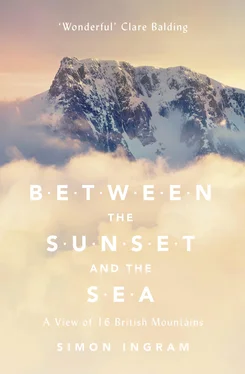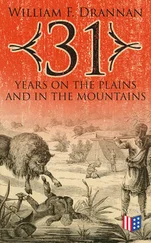This is a convenient viewpoint to take, as a proper definition doesn’t actually exist – neither between a mountain and level ground, nor between a hill and a mountain. The Collins English Dictionary (and I should probably underline here that it’s no worse than any other dictionary in this regard) defines a mountain as ‘higher and steeper than a hill and often having a rocky summit’, and a hill as being ‘a natural elevation of the earth’s surface, less high or craggy than a mountain’. The only thing that seems to be agreed is essentially a loose compositional contrast – mountains are rockier and higher than hills, hills are rounded and lower than mountains – but no specifics as to what extent or with what steepness something has to project from the earth’s surface in order to be classified as one or the other.
If this were an accepted grey area things would be fine, but it isn’t; many still think mountains and hills differ from each other simply because of their height. In September 2008, three amateur surveyors re-measured a mountain in North Wales – Mynydd Graig Goch, in Snowdonia – and found its height to be 2,000 feet, rather than 1,998 feet. The celebratory headlines that followed certainly suggested this constituted the crossing of a significant watermark; the BBC report of 19 September – in a similar vein to many others of the same day – was a simply triumphant ‘Survey turns hill into mountain’. So there is clearly a school of thought sufficiently established to make national news that the appropriate point at which a hill ends and a mountain begins is 2,000 feet – or 609.6 metres. In a pernickity sidenote, many of these reports drew parallels to the 1995 film The Englishman Who Went up a Hill But Came Down a Mountain , whilst quietly ignoring the fact that in this instance (based on a true story and a real eminence – The Garth, near Cardiff) the point where a hill became a mountain was only 1,000 feet.
Either way, and however wonderful both stories were, they get us no closer to a definition. There are many sharp, craggy elevations below 2,000 feet – or even 1,000 feet – that certainly resemble and evoke the idea of a mountain, just as there are plenty over 2,000 feet and 3,000 feet that struggle to resemble the definition of a hill, let alone a mountain. This merely serves to highlight that all these places are different and defy any kind of numerical ring-fencing: a mountain is simply what is made in the eye of the beholder. The pioneer Scottish mountaineer J. H. B. Bell put it rather nicely when he wrote, ‘Whether we are dealing with the little 1,000-foot hill near our homes … or a 20,000-foot giant of the Himalaya … in certain kinds of weather and atmospheric lighting, one can look almost as impressive as the other.’
What we do have instead are classifications – lists, basically – which are less definitions and more ways of grouping the natural shambles of mountains together under something approaching order.
It’s testimony to the fascination of Britain’s high places how many of these lists there are – especially since the presence of mountains does not necessarily an overwhelmingly mountainous country make. Most of Britain’s high places are isolated in ranges in North or South Wales, the Lake District and Pennines of England, and the Uplands, Highlands and Islands of Scotland. Yet despite this fairly lean coverage, Britain is far from short of mountain classifications – many of which, whilst inevitably overlapping to a degree, comprise hundreds of mountains. Amongst others we have the Deweys, Tumps, Hardys, Nuttalls, Donalds, Grahams, Murdos, Corbetts, Wainwrights – and, most venerable of all, the Munros.
If this all seems a bit tedious, don’t worry. We’ll revisit one or two of these lists, but most of them we won’t. And either way, it doesn’t really matter.
Another thing that doesn’t seem to matter is absolute elevation. On paper, the mountains of Britain are – relatively, at least – embarrassingly slight. Not a single one gets remotely close to cracking the 2,000-metre mark, which, as I understand it, is the minimum height a mountain has to be before a French mountaineer can justify the energy required to look up at it. There are car dealerships in Italy higher than the 1,344-metre (4,409-foot) summit of Ben Nevis. The million people who inhabit Guatemala City live, sleep and work higher than our highest point and probably don’t have to do it in a Gore-Tex coat and walking boots. In fact most countries in the world have enough justification to – in the most literal sense – look down on the height of Britain’s modest mountains. Amongst the many, many countries that boast far higher peaks than ours within their borders are the less-than-notably mountaineering nations of Cuba, Guinea, Sri Lanka and Madagascar – with Fiji, Tonga and the Seychelles uncomfortably close to joining that list.
But despite their diminutiveness, people come from all over the world to get our mountains beneath their feet. Many are world famous, and – whilst perhaps not as ballistic or notorious as, say, the Matterhorn or the Eiger – the shadows they throw are far longer than their physical statistics would seem to merit. Perhaps it’s the convenient conservativeness of their height; they’re robust enough to feel big and tall enough to include several distinct ecosystems, but none of them requires more than a day to get up, or hits any altitudes that require acclimatisation. This makes our mountains extraordinarily inclusive, which is further helped by the fact that few require the assistance of a rope to achieve the summit. Given even a basic skill set and fitness, and the willingness to use your hands, outside of winter most people can get to the top of most British peaks under their own steam. Indeed, most host routes to suit all abilities to such a canny degree it’s as if this were a conscious consideration in their design.
Not that they always look straightforward, of course. An amusing story, which time has sadly rendered apocryphal, concerns a visitor from Switzerland who had come to walk up Snowdon. Upon rounding a corner of the Pyg Track, at a point that offers a spectacular view of the mountain’s east face, he froze, before imploring his party to turn back as there was insufficient daylight to make a summit attempt. Snowdon had tricked him; in good conditions the summit from that point is little more than two hours away. This is heartening, because, if you’ve ever seen the Swiss Alps, you’ll know that the mountains there are ridiculous. They’re like daggers, and there are millions of them. The fact that someone who comes from a country with mountains like that would want to come and climb one of ours – let alone be overawed by one – tells us something. It tells us ‘less is more’. It also tells us that whatever it is our mountains have, it isn’t cheapened by abundance or the anonymity of youth. They are dignified. Distinguished. They have something, which, were they alive, you might call a personality.
The names help. Oh, the names. Mountains across the world are usually given evocative names; it’s what comes of being the landscape’s most dramatic natural feature. But the toponymy – a little-deployed word to do with the etymology of place names – of the British mountains has a curiously unique vintage that is both cherishable and maddening, depending on the dexterity of your pronunciation muscles. Thanks to the interbreeding of Middle English, Gaelic, Goidelic Celtic, Old Norse, Anglo-Norman and the odd humorous landlord with a hill’s identity at his disposal, we have within our shores mountains that sound like flaking skin conditions (Slioch); someone choking on a Polo whilst trying to give directions in a Glasgow suburb (Stùc a’ Choire Dhuibh Bhig); unpleasant bodily reflexes (Barf); embarrassing bodily parts (Fan y Bîg); a kind of rice-based snack (Canisp); and the fortress of some medieval villain (Bidean nam Bian). We also have a couple of Cockups (one big, one not so big), a Sergeant, several Old Mans and literally hundreds of Bens. And though I jest, the meanings of some of the more colourful mountain names are as fascinating as they are eclectic. To illustrate this point, I’ll offer just one particularly good example: a hill in North Wales called Pen Llithrig y Wrach. It means ‘Hill of the Slippery Witch’. How can you not love that?
Читать дальше












